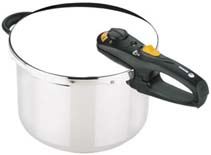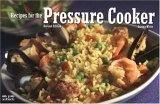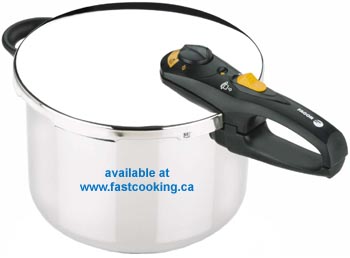The New Generation Pressure Cooker Experts

The Fastest & Best Way to Cook |
![]() Everything about pressure cookers
Everything about pressure cookers ![]()
How long & how do I pressure-cook...
- Meat (beef, pork & lamb)
- Poultry (chicken, turkey & duck)
- Vegetables (fresh & frozen)
- Beans/Lentils/Chickpeas
- Rice & Grains (like oatmeal)
- Seafood & Fish
- Fruit (fresh & dried)
On this page: Pressure-Cooking Times & Instructions
Pressure-Cooking is the Fastest Way to Cook
If you can't find what you are looking for in our pressure cooker time tables and instructions below, have a look at our comprehensive information about pressure-cooking by selecting a topic from the menu on the left above. Also see our gigantic selection of pressure cooker cookbooks in order to have instructions at your fingertips.
More time for you: pressure-cooking with a modern pressure cooker is fast! Pressure cookers save you time by cooking foods TWO to TEN times faster than other cooking methods. They are the fastest way to cook delicious meals: beef roasts, chicken, rice, dry beans, you name it. Pressure-cooked foods are moist and have a much better texture than microwave-cooked foods and cook in a fraction of the time compared to using a slow cooker.
But Not All Pressure Cookers Cook at the Same Speed
You use a pressure cooker to save lots of time and energy cooking delicious food, but only 15 psi (lb) pressure cookers cook at the fastest speed available. If your pressure cooker is less than 15 lb pressure, add more time to that shown in the detailed pressure-cooking time tables below. Learn more about how the amount of pressure of the pressure cooker affects it's cooking time and compare cheap low-pressure pressure cookers to those that operate at 15 lb pressure.
Detailed Pressure-Cooking Time Tables
Vegetables (Fresh and Frozen)
Vegetable pressure-cooking instructions are below the time table.
Other useful pressure-cooking information on this website:
Time Table: Vegetable Cooking Times for Pressure Cookers
(Pressure-cooking instructions are below the time table.)
| Vegetable | Approximate Cooking Time (minutes) |
Pressure Level | |
| Artichoke, large whole, without leaves | 9 to 11 | High | |
| Artichoke, medium whole, without leaves | 6 to 8 | High | |
| Artichoke, small whole, without leaves | 4 to 5 | High | |
| Artichoke, hearts | 2 to 3 | High | |
| Asparagus, fine, whole | 1 to 1 1/2 | High | |
| Asparagus, thick, whole | 1 to 2 | High | |
| Beans, green, whole (fresh or frozen) | 2 to 3 | High | |
| Beets, 1/4" (5 mm) slices | 5 to 6 | High | |
| Beet greens | 1 | High | |
| Beans, yellow, whole (fresh or frozen) | 2 to 3 | High | |
| See our pressure cooker Vegetable Recipes | |||
| Broccoli, flowerets | 2 | High | |
| Broccoli, stalks | 5 to 6 | High | |
| Broccoli, stalks, 1/4" (5 mm) slices | 3 to 4 | High | |
| Brussel sprouts, whole | 4 | High | |
| Cabbage, red or green, in quarters | 3 to 4 | High | |
| Cabbage, red or green, 1/4" (5 mm) slices | 1 | High | |
| Carrots, 1/4" (5 mm) slices | 1 | High | |
| Carrots, 1" (25 mm) chunks | 4 | High | |
| Cauliflower flowerets | 2 to 3 | High | |
| Celery, 1" (25 mm) chunks | 3 | High | |
| Collard | 5 | High | |
| Corn, kernels | 1 | High | |
| Corn on the cob | 3 | High | |
| Eggplant, 1/4" (5 mm) slices | 3 | High | |
| Eggplant, 1/2" (10 mm) chunks | 3 | High | |
| Endive, thickly cut | 1 to 2 | High | |
| Escarole, coarsely chopped | 1 to 2 | High | |
| Green beans, whole (fresh or frozen) | 2 to 3 | High | |
| See our pressure cooker Vegetable Recipes | |||
| Kale, coarsely chopped | 2 | High | |
| Leeks (white part) | 2 to 4 | High | |
| Mixed vegetables, frozen | 2 to 3 | High | |
| Okra, small pods | 2 to 3 | High | |
| Onions, medium whole | 2 to 3 | High | |
| Parsnips, 1/4" (5 mm) slices | 1 | High | |
| Parsnips, 1" (25 mm) slices | 2 to 4 | High | |
| Peas, in the pod | 1 | High | |
| Peas, green | 1 | High | |
| Potatoes, cut into 1" (25 mm) cubes | 5 to 7 | High | |
| Potatoes, new, whole small | 5 to 7 | High | |
| Potatoes, whole large | 10 to 12 | High | |
| Pumpkin, 2" (50 mm) slices | 3 to 4 | High | |
| Red beet, in 1/4" (5 mm) slices | 4 | High | |
| Red beet, large, whole | 20 | High | |
| Red beet, small, whole | 12 | High | |
| Rutabaga, 1/2" (10 mm) slices | 4 | High | |
| Rutabaga, 1" (25 mm) chunks | 5 | High | |
| See our pressure cooker Vegetable Recipes | |||
| Spinach, fresh | 1 | Low | |
| Spinach, frozen | 4 | High | |
| Squash, acorn, halved | 7 | High | |
| Squash, butternut, 1" (25 mm) slices | 4 | High | |
| Sweet potato, 1 1/2" (40 mm) slices | 5 | High | |
| Swede, 1" (25 mm) slices | 7 | High | |
| Swiss chard | 2 | High | |
| Tomatoes, in quarters | 2 | High | |
| Tomatoes, whole | 3 | High | |
| Turnip, small, in quarters | 3 | High | |
| Turnip, in 1 1/2" (40 mm) slices | 3 | High | |
| Yellow beans, whole (fresh or frozen) | 2 to 3 | High | |
| Zucchini, 1/4" (5 mm) slices | 2 | High | |
NOTE: For T-Fal, WMF, Chef's Design, electronic pressure cookers, the 8 psi pressure Lagostina Endura, low cost “no name” pressure cookers and other pressure cookers that are less than 15 pounds (psi) pressure, add additional time to the cooking times in the charts below (check the pressure of your pressure cooker). For a 12 psi pressure cooker, add about 20% more time to the 15 psi pressure cooker cooking times shown in the charts.
 Time to get a new cookbook for your pressure cooker?
Time to get a new cookbook for your pressure cooker?

Vegetable Pressure-Cooking Instructions:
|
Use the quick release method [2] or the automatic release method [3] when the cooking time is completed so vegetables remain crisp. |
|
|
To cook vegetables by themselves in a pressure cooker (i.e. not in a soup or stew), use a steamer basket and trivet. The trivet is the steamer basket's stand. Place the trivet in the bottom of the pressure cooker and then rest the steamer basket on top of the trivet. Pour a 1/2 cup (125 ml) of water in the bottom of the pressure cooker if the vegetable's cooking time is less than 5 minutes. If the cooking time of the vegetable is between 5 and 10 minutes, use 1 cup (250 ml) of water. If the cooking time is between 10 and 20 minutes, use 2 cups (500 ml) of water. Pressure cookers other than Fagor may require more water. Check your pressure cooker's instruction manual. |
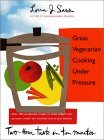 Best prices on pressure cooker cookbooks |
|
Add an additional one to two minutes to the cooking time when using frozen vegetables except where noted otherwise in the time chart. |
Beans/Lentils (chickpeas, dry peas, legumes and other pulses)
Dry bean & lentil cooking instructions are below the time table.
Other useful pressure-cooking information on this website:
|
New Generation 15 psi, easy-to-use, European-designed Reasonably Priced
Fagor is available at our store Food Fast, Without the Guilt.TM |
Time Table: Bean/Legume Cooking Times for Pressure Cookers
(Bean pressure-cooking instructions are below the time table.)
| Bean/Legume | Soaked Natural Release [4] (minutes) |
Soaked Quick Release [2] (minutes) |
Unsoaked Quick Release [2] (minutes) |
Pressure Level |
| Adzuki | 2 to 3 | 5 to 9 | 14 to 20 | High |
| Anasazi | 1 to 2 | 4 to 7 | 20 to 22 | High |
| Beans, black | 3 to 6 | 5 to 9 | 8 to 25 | High |
| Beans, garbanzo (chickpeas) | 9 to 14 | 13 to 18 | 30 to 40 | High |
| Beans, great northern | 4 to 8 | 8 to 12 | 25 to 30 | High |
| Beans, lima, baby | 2 to 3 | 5 to 7 | 12 to 15 | High |
| Beans, lima, large | 1 to 3 | 4 to 7 | 12 to 16 | High |
| Beans, navy or pea or white (haricot) | 3 to 4 | 6 to 8 | 16 to 25 | High |
| Beans, pinto | 1 to 3 | 4 to 6 | 22 to 25 | High |
| See our pressure cooker Bean and Chickpea Recipes | ||||
| Beans, red kidney | 5 to 8 | 10 to 12 | 20 to 25 | High |
| Beans, soy (beige) | 5 to 8 | 9 to 12 | 28 to 35 | High |
| Beans, soy (black) | 16 to 18 | 20 to 22 | 35 to 40 | High |
| Beans, white kidney (cannellini) | 6 to 8 | 30 to 40 | High | |
| Chickpeas (chick peas, garbanzo bean or kabuli) | 9 to 14 | 13 to 18 | 30 to 40 | High |
| Cranberry (romano or borlotti) | 5 to 8 | 9 to 12 | 30 to 34 | High |
| Gandules (pigeon peas) | 2 to 5 | 6 to 9 | 20 to 25 | High |
| Lentils, French green | - | - | 10 to 12 | High |
| Lentils, green, mini (brown) | - | - | 8 to 10 | High |
| Lentils, red, split | - | - | 4 to 6 | High |
| Lentils, yellow, split (moong dal) | - | - | 4 to 6 | High |
| Peas, split, green or yellow | - | - | 6 to 10 | High |
| Peas, dried, whole | 4 to 6 | 8 to 10 | 16 to 18 | High |
| Peas, black eyed | - | - | 10 to 11 | High |
| Scarlet runner | 8 to 10 | 12 to 14 | 17 to 20 | High |
Pressure-cooking time chart Fagor, Presto, Kuhn Rikon, Magefesa, Fissler, Lagostina pressure cooker
NOTE: For T-Fal, WMF, Chef's Design, electronic pressure cookers, the 8 psi pressure Lagostina Endura, low cost “no name” pressure cookers and other pressure cookers that are less than 15 pounds (psi) pressure, add additional time to the cooking times in the charts below (check the pressure of your pressure cooker). For a 12 psi pressure cooker, add about 20% more time to the 15 psi pressure cooker cooking times.
 Time to get a new cookbook for your pressure cooker?
Time to get a new cookbook for your pressure cooker?

Bean Pressure-Cooking Instructions:
|
For the most efficient cooking method, use the natural release method [4] rather than the quick release method [2] for pressure-cooking soaked beans. As this method is not wasteful, it will lower your electricity or gas bills. The natural release method of pressure-cooking soaked beans reduces the amount of time the stove is on and is using electricity or gas. When the stove is on for less time, less heat is given off by the stove. This will also give you the most comfortable room temperature in your kitchen as the room will not heat up as much. If you use air conditioning, the natural release method will reduce how hard your air conditioner needs to work in order to remove the heat generated by your stove. The cooking times for this method are shown in the natural release column in the table above. |
|
|
Do not soak lentils or dried split peas. Before pressure-cooking, soak dry beans in four times their volume of water for four to six hours (don't exceed 12 hours—beans that are soaked for long periods are best for soups or purées as they easily break up). You can start soaking the beans before leaving for work so they will be conveniently ready for pressure-cooking in the evening. Do not add salt to soaking water as it will cause the beans to toughen and inhibit hydration (water absorption). |
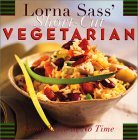 Best prices on pressure cooker cookbooks |
|
If you have forgotten to soak the beans, no problem. The pressure cooker can still cook beans that have not been soaked! The trade-off is that it is not as quick and increases the energy used (makes your kitchen hotter) due to the longer cooking times of unsoaked beans. Speed-soaking (also know as quick-soaking) beans is a faster method than pressure-cooking unsoaked beans. You can speed-soak beans by cooking them on high pressure for one minute and then reducing the pressure by the quick release method [2]. Compared to using the automatic release method [3], using the quick release method reduces the chance that the beans skins will separate from the beans. Drain the water, rinse beans and soak in fresh water for one hour. Then pressure-cook the beans normally using the standard “soaked” cooking times. |
|
|
Place beans/legumes in the pressure cooker. Add 3 cups (750 ml) of water for each 1 cup (250 ml) of beans/legumes. If you have an old-fashion jiggler valve pressure cooker such as a Presto, add 1 to 2 tablespoons (15 to 30 ml) of vegetable oil to the water in the pressure cooker. The oil reduces foaming and the possibility of clogging the vent tube on these old pressure cookers. Do not add salt until after cooking. Watch the cooking time of whole lentils carefully. Whole lentils will turn to mush if cooked too long. We have found that it is better to bring the pressure cooker to pressure by using medium heat rather than full heat. This reduces the chances that the skins of beans will split and come off the beans. |
|
|
Pressure-cooking times vary according to the quality and age of the beans, legumes or other pulses. If the pulses are still hard after pressure-cooking for the recommended cooking time, return to high pressure over high heat and then immediately reduce the heat to the lowest possible level in order to maintain pressure. Cook for a few more minutes. Alternatively, you can continue cooking the pulses uncovered. Add additional water, if necessary. |
|
 Time to get a new cookbook for your pressure cooker?
Time to get a new cookbook for your pressure cooker?

Rice/Grains
Rice & grain pressure-cooking instructions are below the time table.
Other useful pressure-cooking information on this website:
|
New Generation 15 psi, easy-to-use, European-designed Reasonably Priced
Fagor is available at our store Food Fast, Without the Guilt.TM |
Time Table: Rice and Grain Cooking Times for Pressure Cookers
(Rice and grain pressure-cooking instructions are below the time table.)
| Grains (1 cup/250 ml) |
Approximate Water Quantity | Approximate Cooking Time (minutes) |
Pressure Level |
| Barley, pearl | 4 cups (950 ml) | 15 to 20 | High |
| Barley, pot | 3 cups (750 ml) | 20 | High |
| Bulgur | 3 cups (750 ml) | 8 to 10 | High |
| Couscous | 2 cups (500 ml) | 2 to 3 | High |
| Kamut, whole | 3 cups (750 ml) | 10 to 12 | High |
| Learn How to Cook Oatmeal in a Pressure Cooker | |||
| Oats, quick cooking | 1 2/3 cups (400 ml) | 6 | High |
| Oats, steel-cut | 1 2/3 cups (400 ml) | 11 | High |
| Quinoa, quick cooking | 2 cups (500 ml) | 6 | High |
| Rice, basmati | 1 1/2 cups (350 ml) | 5 to 7 | High |
| Rice, brown | 1 1/2 cups (350 ml) | 12 to 15 | High |
| Rice, white | 1 1/2 cups (350 ml) | 5 to 6 | High |
| Rice, wild | 3 cups (750 ml) | 22 to 25 | High |
| See our pressure cooker Rice Recipes | |||
| Spelt berries | 3 cups (750 ml) | 15 | High |
| Wheat berries | 3 cups (750 ml) | 30 | High |
NOTE: For T-Fal, WMF, Chef's Design, electronic pressure cookers, the 8 psi pressure Lagostina Endura, low cost “no name” pressure cookers and other pressure cookers that are less than 15 pounds (psi) pressure, add additional time to the cooking times in the charts below (check the pressure of your pressure cooker). For a 12 psi pressure cooker, add about 20% more time to the 15 psi pressure cooker cooking times.
 Time to get a new cookbook for your pressure cooker?
Time to get a new cookbook for your pressure cooker?

Rice and Grain Pressure-Cooking Instructions:
|
Use the natural release method [4] when the cooking time is completed. |
|
|
Before pressure-cooking, soak whole grain wheat berries and pearl barley in four times their volume of lukewarm water for at least four hours before cooking, or overnight. Do not add salt to water since it will toughen the grains and inhibit hydration. |
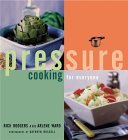 Best prices on pressure cooker cookbooks |
|
Do not soak rice or oats. |
|
Oats: Detailed pressure cooker cooking directions for making oatmeal |
||
|
Rinse under lukewarm water (this also applies to rice). |
|
|
Cook each 1 cup (250 ml) of grain in the amount of water specified. |
Meat & Poultry
Meat & poultry pressure-cooking instructions are below the time table.
Other useful pressure-cooking information on this website:
|
New Generation 15 psi, easy-to-use, European-designed Reasonably Priced
Fagor is available at our store Food Fast, Without the Guilt.TM |
Time Table: Beef, Pork, Lamb, Turkey and Chicken Cooking Times for Pressure Cookers
(Meat pressure-cooking instructions are below the time table.)
| Meat/Poultry | Approximate Cooking Time (minutes) |
Pressure Level |
| Beef, 1" (25 mm) cubes, 1 1/2 lb (700 g) | 10 to 15 | High |
| Beef, dressed, 2 lb (900 g) | 10 to 15 | High |
| Beef, frozen | not advisable | - |
| Beef, heart, 3 to 4 lb (1.4 to 1.8 kg) | 50 to 75 | High |
| Beef, kidney | 8 to 10 | High |
| Beef, liver | 5 | High |
| Beef, meatballs, 1 to 2 lb (450 to 900 g) | 4 to 9 | High |
| Beef, meatloaf, 2 lb (900 g) | 10 to 15 | High |
| Beef, oxtail | 40 to 45 | High |
| Beef, pot roast, rump, round, chuck, blade or brisket, 1 1/2 lb to 2 lb (700 to 900 g) | 35 to 40 | High |
| Beef, ribs, short, grilling | 15 | High |
| Beef, ribs, short, stewing | 20 | High |
| Beef, shanks, 1 1/2" (40 mm) wide | 25 to 30 | High |
| Beef, steak, rump, round, chuck or blade, 1 to 2" (25 to 50 mm) | 20 to 25 | High |
| Beef, stew meat, 1 1/2" (40 mm) cubes | 15 | High |
| See our pressure cooker Beef Recipes | ||
| Chicken, breasts, with bone in, 2 to 3 lb (900 to 1400 g) | 8 to 10 | High |
| Chicken, cubes | 5 [Notes: 2, 3] | High |
| Chicken, drumsticks (legs) or thighs | 5 to 7 [Notes: 2, 3] | High |
| Chicken, ground | 4 [Notes: 2, 3] | High |
| Chicken, frozen, breasts or thighs, boneless | 7 to 10 | High |
| Chicken, liver | 2 [Notes: 2, 3] | High |
| Chicken, strips, boneless | 5 to 6 [Notes: 2, 3] | High |
| Chicken, whole, 2 to 3 lb (900 to 1400 g) | 12 to 18 | High |
| Chicken, whole, 3 to 4 lb (1.4 to 1.8 kg) | 18 to 25 | High |
| Chicken, whole, frozen | not advisable | - |
| See our pressure cooker Chicken Recipes | ||
| Cornish Hen, whole | 8 to 10 | High |
| Duck, pieces | 8 to 10 | High |
| Duck, whole 3 to 4 lb (1.4 to 1.8 kg) | 25 to 30 | High |
| Lamb, 1" (25 mm) cubes, 1 1/2 lb (700 g) | 10 to 18 | High |
| Lamb, chops, 1" (25 mm) thick | 10 [Notes: 2, 3] | High |
| Lamb, leg | 35 to 40 | High |
| Lamb, stew meat | 12 to 15 | High |
| Pheasant | 15 to 20 | High |
| Pork, frozen | not advisable | - |
| Pork, ham shank, 2 lb (900 g) | 20 to 25 | High |
| Pork, ham, pieces | 20 to 25 | High |
| Pork, hocks, smoked (cover completely w/liquid) | 40 to 50 | High |
| Pork, ribs, 2 lb (900 g) | 15 | High |
| Pork, roast | 40 to 45 | High |
| See our pressure cooker Pork Recipes | ||
| Turkey, breast, boneless | 20 | High |
| Turkey, breast, whole, with bone in | 20 to 30 | High |
| Turkey, drumsticks (leg) | 12 | High |
NOTE: For T-Fal, WMF, Chef's Design, electronic pressure cookers, the 8 psi pressure Lagostina Endura, low cost “no name” pressure cookers and other pressure cookers that are less than 15 pounds (psi) pressure, add additional time to the cooking times in the charts below (check the pressure of your pressure cooker). For a 12 psi pressure cooker, add about 20% more time to the 15 psi pressure cooker cooking times.
 Time to get a new cookbook for your pressure cooker?
Time to get a new cookbook for your pressure cooker?

Meat Pressure-Cooking Instructions:
|
Unless indicated in the notes in brackets, use the natural release method [4] when the cooking time is completed. |
|
|
Always pressure-cook meat or poultry with at least 1/2 cup (125 ml) of liquid (water, stock, etc.) in the bottom of the pressure cooker. Pressure cookers other than Fagor may require more than 1/2 cup (125 ml). Check your pressure cooker's instruction manual. If cooking time is between 5 and 10 minutes, use 1 cup (250 ml) of liquid. If cooking time is between 10 and 45 minutes, use 2 cups (500 ml) of liquid. Preserved or salted meats should be completely immersed in water. |
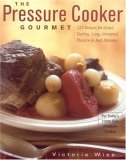 Best prices on pressure cooker cookbooks |
|
Unless indicated, the cooking times given below are for 3 lb (1.4 kg) of meat or poultry. Exact cooking times for meat and poultry vary according to the quality and quantity of meat or poultry being cooked. The denser the cut, the longer the cooking time should be. If pressure-cooked chicken is stringy or chewy, you have pressure-cooked it too long. |
|
|
To produce maximum flavour, the Maillard reaction needs to occur. Brown the meat or poultry on all sides in the pressure cooker using a vegetable oil such as canola oil before locking the lid and pressure-cooking. Heat the vegetable oil in a high-walled pressure cooker over medium high heat before inserting the meat or poultry to brown it. A pressure cooker with high walls will contain oil spatter during browning. |
Other useful pressure-cooking information on this website:
|
New Generation 15 psi, easy-to-use, European-designed Reasonably Priced
Fagor is available at our store Food Fast, Without the Guilt.TM |
Seafood & Fish
Seafood & fish pressure-cooking instructions are below the time table.
Other useful pressure-cooking information on this website:
Time Table: Seafood and Fish Cooking Times for Pressure Cookers
(Pressure-cooking instructions are below the time table.)
| Seafood and Fish |
Approximate Cooking Time (minutes) |
Pressure Level |
| Crab | 2 to 3 | Low |
| Fish fillet | 2 to 3 | Low |
| Fish steak | 3 to 4 | High |
| Fish, whole, gutted | 5 to 6 | Low |
| Fish soup or stock | 5 to 6 | High |
| Lobster, 1 1/2 to 2 lb (700 to 900 g) | 2 to 3 | Low |
| Mussels | 2 to 3 | Low |
| Prawns (shrimp) | 1 to 2 | Low |
NOTE: For T-Fal, WMF, Chef's Design, electronic pressure cookers, the 8 psi pressure Lagostina Endura, low cost “no name” pressure cookers and other pressure cookers that are less than 15 pounds (psi) pressure, add additional time to the cooking times in the charts below (check the pressure of your pressure cooker). For a 12 psi pressure cooker, add about 20% more time to the 15 psi pressure cooker cooking times.
 Time to get a new cookbook for your pressure cooker?
Time to get a new cookbook for your pressure cooker?

Seafood Pressure-Cooking Instructions:
|
Use the quick release method [2] when the cooking time is completed. |
|
Cook seafood in the pressure cooker steamer basket on the support trivet with at least 175 ml (3/4 cup) of liquid. Apply a fine layer of vegetable oil to the steamer basket when you cook fish. |
|
New Generation 15 psi, easy-to-use, European-designed Reasonably Priced
Fagor is available at our store Food Fast, Without the Guilt.TM |
Fruit (Fresh & Dried)
Fruit pressure-cooking instructions are below the time table.
Other useful pressure-cooking information on this website:
Time Table: Fruit Cooking Times for Pressure Cookers
(Fruit pressure-cooking instructions are below the time table.)
| Fruit |
Approximate Cooking Time (minutes) |
Pressure Level |
| Apples, dried | 3 | High |
| Apples, fresh in slices or pieces | 2 to 3 | Low |
| Apricots, dried | 4 | High |
| Apricots, fresh, whole or in halves | 2 to 3 | Low |
| Peaches, dried | 4 to 5 | High |
| Peaches, fresh in halves | 3 | Low |
| Pears, dried | 4 to 5 | High |
| Pears, fresh in halves | 3 to 4 | Low |
| Prunes | 4 to 5 | High |
| Raisins | 4 to 5 | High |
NOTE: For T-Fal, WMF, Chef's Design, electronic pressure cookers, the 8 psi pressure Lagostina Endura, low cost “no name” pressure cookers and other pressure cookers that are less than 15 pounds (psi) pressure, add additional time to the cooking times in the charts below (check the pressure of your pressure cooker). For a 12 psi pressure cooker, add about 20% more time to the 15 psi pressure cooker cooking times.
 Time to get a new cookbook for your pressure cooker?
Time to get a new cookbook for your pressure cooker?

Fruit Pressure-Cooking Instructions:
|
Use the quick release method [2] or the automatic release method [3] when the cooking time is completed so the fruit is not overcooked. |
|
Cook fresh fruit in the pressure cooker steamer basket, using 1/2 cup (125 ml) of water in the bottom of the pressure cooker. Pressure cookers other than Fagor may require more water. Check your pressure cooker's manual. Use 1 cup (250 ml) of water or fruit juice for each cup of dried fruit. |
* Plus time for natural release (see Note 4 below).
Notes:
1There are many health questions surrounding the microwave cooking of the plastic packaging used with most microwavable foods. Also, as a point of interest, most microwave ovens contain hazardous materials such as lead and brominated flame retardants in their electrical circuitry.
2Quick Release Method. Also called the cold-water release method, is used to release pressure quickly. To use this method, remove the pressure cooker from the burner, place in the sink and run cold tap water gently over the lid until steam dissipates and the pressure indicator is lowered. When putting the pressure cooker in the sink, tilt the handle up so the water flows away from you.
3Automatic Release Method. Turn the pressure selector dial on the lid to the release position and the steam will release. On most Kuhn Rikon pressure cookers, lightly press the pressure indicator's stem.
4Natural Release Method. To use this method, remove the pressure cooker from the hot burner and let the pressure drop by cooling down naturally.
More Time for You
|
New Generation 15 psi, easy-to-use, European-designed Reasonably Priced
Fagor is available at our store Food Fast, Without the Guilt.TM |
